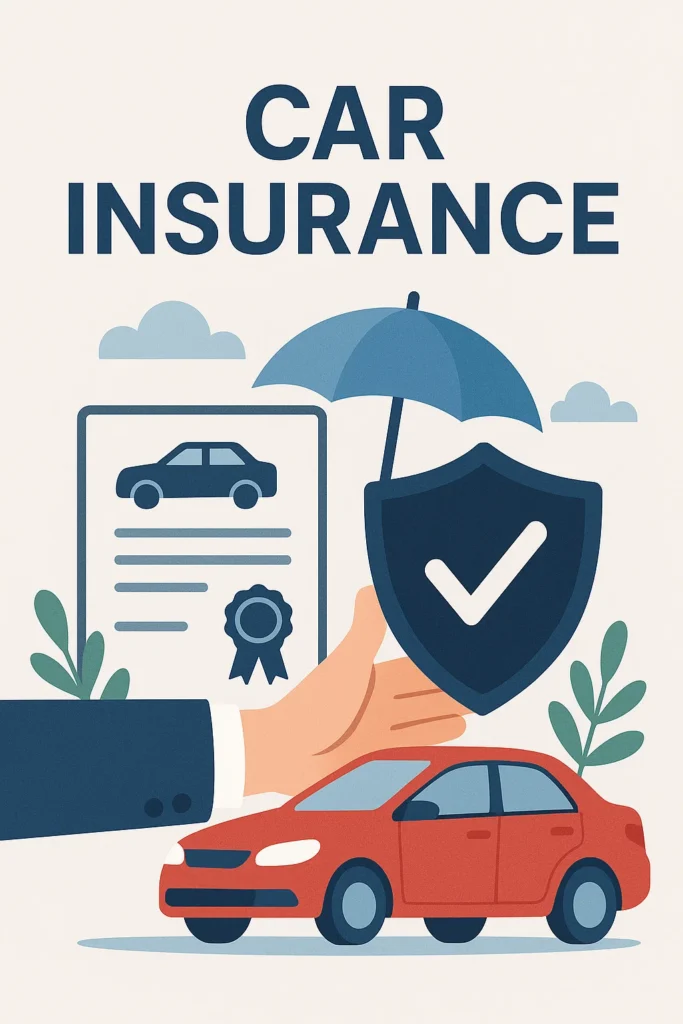





🚗 Introduction: Not All Car Insurance Is the Same
If you’re shopping for car insurance in the USA, you’ll quickly realize there’s more than just one type. Some cover damage to your car, some cover damage to others, and others protect you from unexpected events like theft or storms.
Knowing the main types of car insurance can help you pick the right plan and avoid paying for things you don’t need.
🛡️ 1. Liability Insurance – Required by Law
What It Covers:
- Damage you cause to another car
- Injuries you cause to other people
Why It’s Important:
This is the minimum coverage required in most states. If you cause an accident, it protects other people, not you or your car.
📌 Example:
You rear-end someone’s car and it costs $3,000 to fix. Liability insurance pays for it.
⚠️ Note: It does NOT pay to fix your own car.

🚙 2. Collision Insurance – Protects Your Own Car
What It Covers:
- Damage to your car from a crash, even if you are at fault
Why It’s Important:
If you hit a tree, a pole, or another car, this coverage pays to fix or replace your car.
📌 Example:
You hit a wall and your car repairs cost $4,000. Collision insurance covers it (minus your deductible).
💡 Best for: New cars or if you want full protection.
🌪️ 3. Comprehensive Insurance – For Non-Crash Events
What It Covers:
- Theft
- Vandalism
- Fire
- Natural disasters (hail, flooding, falling trees)
- Hitting animals (like a deer)
Why It’s Important:
Comprehensive covers everything except a crash.
📌 Example:
A storm breaks your windshield or your car gets stolen — this insurance pays for it.
💡 Tip: If you park outside or live in a high-risk area, this is a must.
🧑⚕️ 4. Personal Injury Protection (PIP) – Medical Coverage
What It Covers:
- Your medical bills after an accident
- Medical bills for your passengers
- Lost income due to injury
- Funeral costs (in worst-case scenarios)
Why It’s Important:
Even if you have health insurance, PIP helps cover accident-related medical expenses quickly.
📌 Example:
You break your arm in a car crash and can’t work for a week. PIP pays for treatment and lost wages.
🏥 Required in some states like Florida and New York.
🚧 5. Uninsured/Underinsured Motorist Coverage – For the Other Guy’s Mistake
What It Covers:
- Accidents caused by someone who has no insurance
- Accidents where the other driver has too little insurance
Why It’s Important:
Not everyone follows the law. If someone hits you and they’re not insured, you’re still protected.
📌 Example:
A driver with no insurance crashes into you. This coverage pays for your car repairs and medical bills.
🚫 1 in 8 drivers in the U.S. has no insurance.
Broken-down car with a “No Insurance” sign on the other driver’s vehicle
📊 Quick Comparison Chart
| Type | Covers Your Car | Covers Others | Covers Medical | Required? |
|---|---|---|---|---|
| Liability | ❌ | ✅ | ❌ | ✅ (most states) |
| Collision | ✅ | ❌ | ❌ | Optional |
| Comprehensive | ✅ (non-crash) | ❌ | ❌ | Optional |
| Personal Injury Protection | ❌ | ❌ | ✅ | Some states |
| Uninsured Motorist | ✅ | ❌ | ✅ | Some states |
🤔 How Do I Choose the Right Types?
Ask yourself:
- Do I drive often?
- Is my car new or expensive?
- Can I afford repairs out of pocket?
- Do I live in an area with storms, theft, or lots of accidents?
📝 Pro Tip: A full coverage policy usually includes liability + collision + comprehensive.
✅ FAQs
Q: Can I mix and match types of coverage?
A: Yes! You can choose what suits your needs and budget.
Q: Is full coverage required?
A: No, but if you’re financing a car, lenders usually require it.
Q: How can I get a good deal on all types?
A: Compare quotes online and ask for bundling discounts.
🔚 Conclusion: Know What You’re Paying For
Choosing the right type of car insurance helps you stay protected — and saves you from surprise bills later. Whether you’re a new driver or just reviewing your policy, these five coverages are the basics you should know.
